Thirty-one pieces were collected from Layers B - F. These are classified as pestles, querns, abrading stones, stone axes, double-edged stone clubs, bar-shaped stone clubs, a perforated pebble, a chopper, a chipped arrowhead, and chipped stones.
1. Classification
(a) Pestles
There are total of thirteen pestles, the highest quantity for any stone artifact type. These implements have either one or two surfaces smoothed and polished to varying degrees by secondary use. They can be subclassified as follows:
- I. Biface type (with two grinding surfaces)
- A) shaped
- B) shaped, with shallow depression
- C) unshaped
- II. Uniface type (with one grinding surface)
- A) unshaped
The group A biface pestle is either round or oval in outline and rectangular in cross section (Figs. 6:1-5, 7:1, Plate XIV: 1-6). The group B is the same shape as the group A but has a small, shallow depression in each face (Fig. 6:1, 2, Plate XIV:4, 6). The group C pestle is a pebble with no sign of artificial shaping (Figs. 6:6, 7:4, Plates XIV:7, XV: 1, 5). There are six group A and B pestles, all having two grinding surfaces and showing pecked and ground lateral edges. The grinding surfaces are flat from use. The small, shallow depressions on the B group pestles are 15-20 mm in diameter and 3 mm in depth. The grinding surfaces of the C group pestles are convex, strikingly different from those on the A and B group pestles.

Figure 6: Stone artifacts. Pestles of biface type with two grinding surfaces (Scale1/2).
1 (K-23); Pestle of biface type (fragment). Shaped block with small shallow depression in each surface. Grinding surfaces roughly parallel and flat. From layer E. Material, tuffaceous sandstone (Hate XIV:4).
2 (K-22); Pestle of biface type. Shaped block with small shallow depression in each surface. Round in outline. Grinding surfaces parallel and flat. From layer E. Material, gabbro (Plate XIV:6).
3 (K-21); Pestle of biface type. Shaped block. Round in outline and rectangular in cross section. Grinding surfaces parallel and flat. From layer E. Material, andesite (Plate XIV :3).
4 (K-24); Pestle of biface type. Bell-shaped block. Oval in cross section. Grinding surfaces roughly parallel and convex. Battered end. From layer E. Material, unidentified (Plate XIV:5).
5 (K-20); Pestle of biface type. Slab-shaped block. Round in outline and rectangular in cross section. Grinding surfaces parallel and flat. From layer E. Material, andesite (Plate XIV :2).
6 (K-26); Pestle of biface type (fragment). Unshaped block. Grinding surfaces convex. From layer E. Material, andesite (Plate XV:1).
7 (K-25); Pestle of biface type (fragment). Unshaped block. Grinding surfaces roughly parallel and convex. From layer E. Material, andesite (Plate XV:7). |

Figure 7: Stone artifacts. Pestles of biface type with two grinding surfaces (1,4) and uniface type with single grinding surfaces (2,3,5) (Scale 1/2).
1 (K-5); Pestle of biface type. Shaped block. Round in outline and roughly rectangular in cross section. Grinding surfaces parallel and slightly convex. From layer C.Material, andesite (Plate XIV: 1).
2 (K-7); Pestle of uniface type. Unshaped block. Roughly rectangular in outline and oval in cross section. Grinding surface convex. From layer C. Material, unidentified (Plate XIV :9).
3 (K-l); Pestle of uniface type. Unshaped block. Grinding surface at the distal end. Convex. From layer B. Material, fossil bearing sandstone (Plate XV:6).
4 (K-6); Pestle of biface type. Unshaped block. Roughly round in outline and oval to rectangular in cross section. One of grinding surfaces convex and another slightly concave. From layer C. Material, gabbro (Plate XIV:7).
5 (K-16); Pestle of uniface type. Unshaped block. Round in outline and roughly oval in cross section. Grinding surface convex. From layer D. Material, unidentified (Plate XV:3). |
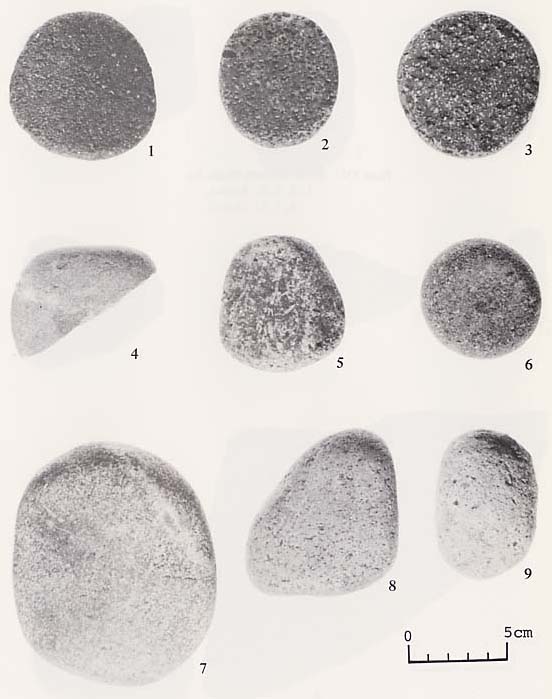
Plate XIV: Stone artifacts (Scale 1/2). Pestles |
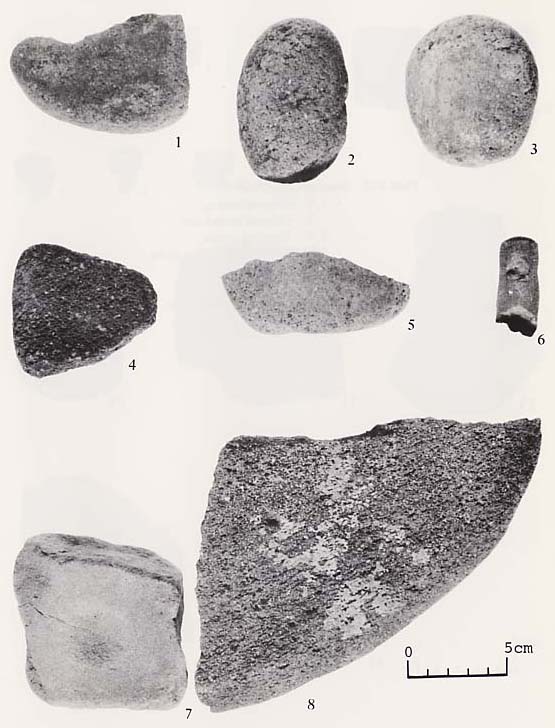
Plate XV: Stone artifacts (Scale 1/2).
1-3,5,6; Pestles, 4,7,8; Querns |
The uniface type pestles have a single grinding surface and are unshaped (Figs. 7:2, 3, 5, 8:1, 2, Plates XIV;8, 9, XV;2, 3). There is a large amount of cortex left on both faces. Four of this type are fist-sized blocks of stone (Figs. 7:2,5, 8:1,2, Plates XIV:8, 9, XV:2, 3). A fifth one has a grinding surface on the top of an elongated pebble (Fig. 7:3, Plate XV:6).

Figure 8: Stone artifacts. Pestles ofuniface type with single grinding surfaces (1,2), and querns of uniface (3) and biface (4) types (Scale 1/2).
1 (K-27); Pestle of uniface type. Unshaped block. Roughly oval in outline and in longitudinal section Grinding surface convex. From layer F. Material, unidentified (Plate XV:2).
2 (K-28); Pestle ofuniface type. Unshaped block. Roughly triangular in outline. Grinding surface flat. From layer F. Material, unidentified (Plate XIV: 8).
3 (K-17); Quern of uniface type with single grinding surface (fragment). Small shallow cup-shaped depression in each surface. From layer D. Material, tuffaceous sandstone (Plate XV;7).
4 (K-18); Quern of biface type with two grinding surfaces (fragment). Shaped block with two grlnding surfaces worn to basin-like depressions on both sides. Grinding surfaces smooth. Small shallow cup-shaped depression on the lateral side. From layer D. Material, andesite (Plate XV:4). |
(b) Querns
There are three querns - slab-like blocks of stone with basin-like grinding surfaces on one or both sides. Since all examples are fragments, exact descriptions are not possible. However, there appear to be two kinds of querns: A) two bifacial querns whose lateral edges have been shaped by pecking and grinding, and whose outline is probably round (Figs. 8:3, 9:1, Plate XV;4, 8), and B) one unifacial quern with no traces of artifical shaping (Fig. 8:3, Plate XV: 7). One of the bifacial querns has a small, shallow depression 15 mm in diameter and approximately 3 mm deep on one edge (Fig. 8:4). The unshaped, unifacial quern has a smooth, slightly basin-like depression showing traces of use on one face and a small shallow depression in each face of a flat stone block (Fig. 8:3, Plate XV: 7).

Figure 9: Stone artifacts. Quern of biface type (1), stone axes of chipped (2) and polished (5) types, and abrading stones (3,4) (Scale 1/2).
1 (K-29); Quern of biface type with two grinding surfaces (fragment). Shaped block. Basin-like grinding surfaces on both sides. Grinding surfaces smooth. From layer F. Material, andesite (Plate XV: 8).
2 (K-30); Stone axe of chipped type. Fiddle-shaped. From layer F. Material, andesite (Plate XVI:12).
3 (K-8); Abrading stone (fragment). Pebble of coarse-grained stone with worked surfaces that show secondary use for grinding. From layer C. Material, sandstone (Plate XVI: 3).
4 (K-19); Abrading stone. Oblong pebble of coarse-grained stone with slightly concave and worked surfaces and lateral edges that show use for grinding. From layer D. Material, tuffaceous sandstone (Plate XVI :4).
5 (K-10); Stone axe of polished type (fragment). Quadrangular type. From layer C. Material, mudstone (Plate XVI: 10). |
(c) Abrading Stones
There are two abrading stones. These are oblong, flat, coarse-grained pebbles. Both faces are smoothed by use, but the lateral edges are blunt (Fig, 9:3,4, Plate XVI:3, 4).

Plate XVI: Stone artifacts (Scale 1/2).
1,7,9; Chipped stones,
2; Chipped arrowhead,
3,4; Abrading stones,
5,6; Double-edged stone clubs,
8; Perforated pebble,
10. 12; Stone axes,
11. 13; Bar-shaped stone clubs,
14; Chopper |
(d) Stone Axes
One polished and one chipped stone axe were found. The polished one is a fragment from the blade end of the axe (Fig. 9:5, Plate XVI: 10). The surface is polished and smoothed. Its outline is roughly rectangular. The chipped one is the so-called fiddle-shaped type with blunt edges and no traces of polishing. Most of the surface is chipped but cortex remains on one side of the back (Fig. 9:2, Plate XVI: 12).
(e) Double-edged Stone Clubs
Fragments of two double-edged stone clubs were found. Both have roughly oval cross-sections (Fig. 10:1-2, Plate XVI:5-6). The whole surface is shaped by pecking and grinding. The sides have no traces of battering from use but are blunt. (Complete examples of this implement are phallicin outline, but their thin, oval cross-sections cause them to resemble swords more than phalli.)

Figure 10: Stone artifacts. Double-edged stone clubs (1,2), chipped arrow head (3), perforated pebble (4), bar-shaped stone clubs (5,6), chopper (7) and chipped stones (8-10) (Scale 1/2).
1 (K-12); Double-edged stone club (fragment). Oblong stone with dull edges. Pecked and polished surfaces smooth. From layer C. Material, crystalline schist (Plate XVI:6).
2 (K-11); Double-edged stone club (fragment). Oblong stone with dull edges. Polished, smooth surfaces. From layer C. Material, unidentified (Plate XVI:5).
3 (K-9); Chipped arrowhead. Broken tip. Triangular point with small triangular stem. From layer C. Material, chert (Plate XVI:2).
4 (K-2); Perforated pebble. Thin, flat pebble with hole drilled at corner side. From layer B. Material, mudstone (Plate XVI:8).
5 (K-13); Bar-shaped stone club (fragment). Roughly round in cross section. Polished, smooth surfaces. From layer C. Material, andesite (Plate XVI:13).
6 (K-31); Flaked surface of bar-shaped stone club, and chipped for re-using as chopper. From layer F. Material, unidentified (Plate XVI:11).
7 (K-14); Chopper. Large angular core implement having one side flaked to a sharp cutting edge, From layer C. Material, sandstone (Plate XVI: 14).
8 (k-4); Chipped stone. Trimmed on ventral surface of proximal end. Possibly notched element. From layer B. Material, chert (Plate XVI:9).
9 (K-15); Chipped stone (fragment). From layer C. Material, obsidian (Plate XVI:7).
10 (K-3); Chipped stone (fragment). From layer B. Material, obsidian (Plate XVI: 1). |
(f) Bar-shaped Stone Clubs
Fragments of two bar-shaped stone clubs were found. One fragment is a piece flaked from a club and probably reused as a chopper-like implement (Fig. 10:6, Plate XVI: 11). (Complete examples of this implement have round cross-sections and closely resemble phalli.)
(g) Perforated Pebble
This is a small, thin, flat pebble with a small hole in one corner. The hole is drilled from one side and is wide (4 mm) on that side but narrow (1.5 mm) on the other (Fig. 10:4, Plate XVI:8).
(h) Chopper
This is a large angular pebble with a cutting edge chipped on one edge and a large amount of cortex left on both faces (Fig. 10:7, Plate XVI: 14).
(i) Chipped Arrowhead
This is an elongated point with a small, triangular stem (Fig. 10:3, Plate XVI:2). The tip is broken. It is elaborately flaked over its entire surface.
(j) Chipped Stones
Three artificially chipped stones were found. However, it is questionable whether they are finished products. Moreover, two of them are fragments, and it is unclear what kind of tool they are meant to be (Fig. 10:9,10, Plate XVI;1, 7). The third one is unifacially flaked on the ventral surface at the proximal end to form a concave edge and is probably a notched implement (Fig. 10:8, Plate XVI:9).
2. Remarks on the Stone Artifacts
1) Frequency by Layer (Table 7)
Layer C shows a marked increase in the quantity of stone artifacts collected. This is thought to be related to the fact that the deposits of Layer C are the greatest in volume. On the other hand, Layers A and B produced only a few artifacts although the excavated areas are relatively large. In Layer A this can be explained by the fact that the field is cultivated every season and the stones discovered during cultivation are thrown away.
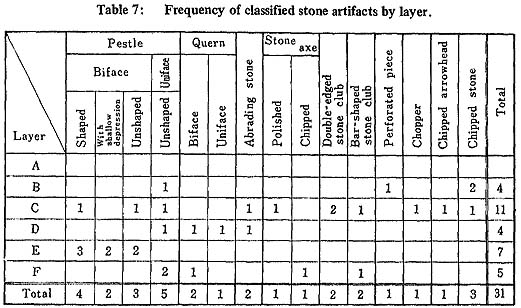
2) Materials (Tables 8,9)
It is thought that there is a relationship between tool types and stone types. Generally, coarse-grained stones such as sandstone and andesite are used for tools without sharp cutting edges like pestles, querns and abrading stones. On the other hand, fine-grained materials such as chert, obsidian and crystalline schist are used for cutting tools like arrowheads and polished axes.
Andesite implements decrease in frequency in the upper layers (Table 9). This change in quantity appears to correspond to similar changes in total quantity of stones (Table 6).
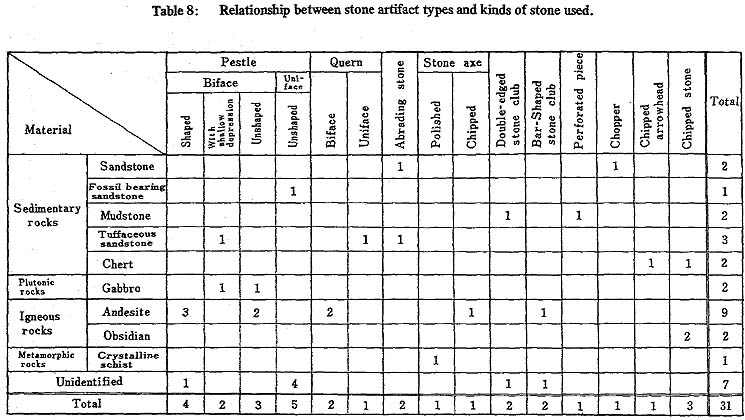
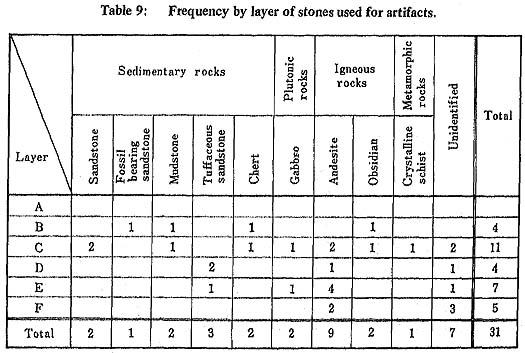
|










